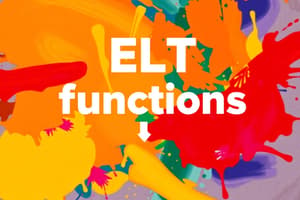Podcast
Questions and Answers
How does language research contribute to the field of language teaching and learning?
How does language research contribute to the field of language teaching and learning?
- By focusing solely on theoretical aspects, ignoring practical applications.
- By systematically investigating methods, practices, theories, and applications. (correct)
- By relying on anecdotal evidence rather than empirical data.
- By providing subjective opinions on teaching methodologies.
Which research methodology is characterized by in-depth investigation and is useful for exploring complex issues in ELT?
Which research methodology is characterized by in-depth investigation and is useful for exploring complex issues in ELT?
- Ethnographic Research
- Discourse Analysis
- Quantitative Research
- Case Study Research (correct)
A researcher aims to understand the changes in students' attitudes towards learning English after implementing a new teaching method. What type of research is most suitable?
A researcher aims to understand the changes in students' attitudes towards learning English after implementing a new teaching method. What type of research is most suitable?
- Ethnographic Research
- Case Study Research
- Action Research (correct)
- Quantitative Research
What is a key characteristic of qualitative research in the context of English Language Teaching?
What is a key characteristic of qualitative research in the context of English Language Teaching?
Which of the following data collection methods is commonly associated with qualitative research?
Which of the following data collection methods is commonly associated with qualitative research?
Which of the following is a primary strength of qualitative research in ELT?
Which of the following is a primary strength of qualitative research in ELT?
In quantitative research, what is the primary focus of data collection?
In quantitative research, what is the primary focus of data collection?
A researcher wants to determine if there is a correlation between students' scores on a vocabulary test and their reading comprehension levels. Which analysis technique is most appropriate?
A researcher wants to determine if there is a correlation between students' scores on a vocabulary test and their reading comprehension levels. Which analysis technique is most appropriate?
What is a key advantage of using quantitative research methods in ELT?
What is a key advantage of using quantitative research methods in ELT?
Which research approach combines qualitative and quantitative methods?
Which research approach combines qualitative and quantitative methods?
What type of data collection might be utilized in mixed-methods research?
What type of data collection might be utilized in mixed-methods research?
What is a key strength of mixed-methods research?
What is a key strength of mixed-methods research?
A study aims to examine the impact of a teaching strategy by exploring both students' experiences and test results. Which research approach is most appropriate?
A study aims to examine the impact of a teaching strategy by exploring both students' experiences and test results. Which research approach is most appropriate?
Which theoretical framework emphasizes the role of social interaction and cultural context in learning?
Which theoretical framework emphasizes the role of social interaction and cultural context in learning?
According to sociocultural theory, what concept describes the difference between what a learner can do independently and what they can achieve with guidance?
According to sociocultural theory, what concept describes the difference between what a learner can do independently and what they can achieve with guidance?
Flashcards
Language Research
Language Research
A systematic investigation of methods, practices, theories, and applications in the context of language teaching and learning.
Second Language Acquisition (SLA)
Second Language Acquisition (SLA)
An area of language research focused on how people learn a second language.
Teaching Methods and Approaches
Teaching Methods and Approaches
Research focused on the strategies and techniques used by teachers in the classroom.
Curriculum and Material Development
Curriculum and Material Development
Signup and view all the flashcards
Computer-Assisted Instruction (CAI)
Computer-Assisted Instruction (CAI)
Signup and view all the flashcards
Teacher Professional Development
Teacher Professional Development
Signup and view all the flashcards
Assessment and Evaluation
Assessment and Evaluation
Signup and view all the flashcards
Qualitative Research
Qualitative Research
Signup and view all the flashcards
Quantitative Research
Quantitative Research
Signup and view all the flashcards
Mixed-Methods Research
Mixed-Methods Research
Signup and view all the flashcards
Action Research
Action Research
Signup and view all the flashcards
Case Study Research
Case Study Research
Signup and view all the flashcards
Discourse Analysis
Discourse Analysis
Signup and view all the flashcards
Ethnographic Research
Ethnographic Research
Signup and view all the flashcards
Behaviorism
Behaviorism
Signup and view all the flashcards
Study Notes
- Language research is the systematic investigation of methods, practices, theories, and applications in the context of language teaching and learning.
- Vincent Ree B. Aguilar, a MAELT-AI student, is the discussant.
Key Areas of Language Research
- SLA or Second Language Acquisition, is a key area.
- Teaching Methods and Approaches, is a key area.
- Curriculum and Material Development, is a key area.
- Computer-Assisted Instruction (CAI), is a key area.
- Teacher Professional Development, is a key area.
- Assessment and Evaluation, is a key area.
Methodologies in English Language Teaching (ELT) Research
- Qualitative Research involves interviews, focus group discussions, and class observations.
- Quantitative Research uses surveys, questionnaires, and statistics.
- Mixed-Methods Research combines both quantitative and qualitative approaches.
- Action Research involves class observations and student feedback.
- Case Study Research includes in-depth investigation.
- Discourse Analysis uses transcripts, dialogues, and speeches.
- Ethnographic Research involves long-term immersion and field notes.
Qualitative Research
- Focuses on the perspectives of the participants.
- Involves in-depth analysis of experiences, behaviors, and interactions.
- Emphasizes the "how" and "why" of teaching and learning.
- Data collection methods include interviews, focus group discussions (FGDs), case studies, and reflective journals.
- Analysis involves thematic analysis, discourse analysis, and/or content analysis.
- Provides rich, detailed insights into teaching practices.
- Commonly used to explore teacher beliefs, student motivations, and class interaction in ELT.
Quantitative Research
- Quantifies language learning outcomes through numerical data.
- Data is collected through surveys, tests, questionnaires, experimental designs, and statistical analysis.
- Analysis includes statistical techniques like descriptive statistics, inferential statistics, and correlation analysis to draw conclusions.
- Allows analysis of large sample sizes and generalizable conclusions about trends or patterns in language learning.
- Commonly used in ELT for analyzing test scores and evaluating learner progress.
Mixed-Methods Research
- Combines qualitative and quantitative approaches.
- Data collection combines qualitative methods such as interviews and observations with quantitative methods like surveys and tests.
- Analysis involves the integration of both qualitative themes and quantitative statistical analysis.
- Utilizes the strengths of both qualitative and quantitative methods.
- Used in ELT to investigate the impact of a teaching strategy by examining both learners' experiences (qualitative) and test results (quantitative).
Theoretical Frameworks
- Theoretical frameworks include behaviorism, cognitivism, constructivism, sociocultural perspectives, monitor model theory and interactionism.
Studying That Suits You
Use AI to generate personalized quizzes and flashcards to suit your learning preferences.



